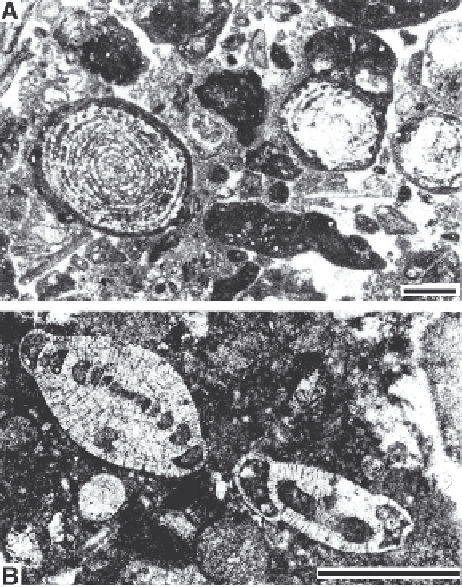Geology Reference
In-Depth Information
as well as environmental conditions (water energy,
paleobathymetry and sedimentation rates) to be recog-
nized.
The use of Late Paleozoic smaller foraminifera in
microfacies studies requires
•
closely spaced sampling (within a distance of < 10 m,
often within a distance of less than 1 m),
•
samples displaying the diversity of the foraminifera
(e.g. Pl. 67/1),
•
systematic determination based on well-defined sec-
tion plains (Conil et al. 1979),
•
quantitative analysis using the number of different
taxa (e.g. per square centimeter of thin-sections),
presence/absence patterns, and
•
statistical treatment of the quantitative data (Gal-
lagher 1997).
The millimeter- to centimeter-sized
fusulinid fora-
minifera
(Pl. 68) are excellent biostratigraphic mark-
ers on stable, shallow carbonate shelves. The global
and regional zonation of the Middle Carboniferous to
Late Permian shelf carbonates relies on a succession
of genera and species (Ross and Ross 1987). Fusulin-
ids are multichambered. Growth starts with an initial
chamber (proloculus). Specimens of sexual generation
have a small microspheric proloculus, those of asexual
generations a large megalospheric proloculus. Cham-
bers are added to form a coiled shell by extension of
the spiral wall (spirotheca). After several chambers are
added, a central tunnel is resorbed through the septa
allowing free communication between the chambers.
Main evolutionary trends are an increase in the size of
the initial chamber, an increase in overall size, and an
increase in the complexity of the test wall.
Fig. 10.27.
Involutinid foraminifera
are abundant elements
of reefal Late Triassic carbonate platforms (see Pl. 111).
A:
Triasina hantkeni
Majzon defines a Rhaetian biozone. The
species occurs in open-marine platform environments. Allgäu,
southern Bavaria, Germany.
B
:
Angulodiscus permodiscoides
Oberhauser and related taxa
are common in muddy near-reef sediments. Left subaxial sec-
tion, right oblique-horizontal section. Note the distinct fibro-
hyaline wall structure. Late Triassic (Rhaetian): Kendelbach-
graben, Austria. Scale is 500
m. Further Triassic foramin-
ifera are depicted on Pl. 111.
sedimentary infillings (Kahler 1988). Worn and rounded
fusulinid tests as well as mixtures of juvenile and adult
specimens are indicative of transport, erosion and
redeposition processes that may sometimes produce
mixtures of fusulinids derived from different
subenvironments (Fig. 10.26), or even different strati-
graphic ages.
Note that present classifications differentiate a sub-
order Fusulinina that includes the large-sized typical
Fusulinacea as well as various groups of smaller
foraminifera.
Fusulinids were adapted to shallow warm and warm-
temperate waters, usually in tropical and subtropical
regions on shelves, platforms and reefs. They lived in
normal marine, well-oxygenated environments on sub-
tidal open shelves, in depths between a few meters to a
few tens of meters. Variations in test shape indicate
specialization to different shallow water subenviron-
ments (e.g. sand bars). Spindle-shaped fusulinids with
pole torsions were concentrated in high-energy stress
environments, spherical forms in low-energy lagoonal
environments (Ross 1982). The life habits and tapho-
nomic history of fusulinids can be derived from shell
construction, encrustation patterns, shell damage, and
Carboniferous and Early Permian fusulinids are par-
ticularly common in bedded medium to light gray grain-
stones, pack- and wackestones deposited on shallow
carbonate shelves, banks and platforms, and in calcar-
eous shales. They mark specific levels in cyclic suc-
cessions. Middle and Late Permian verbeekinid and
neoschwagerinid fusulinids are often associated with
platform margin reefs (Pl. 68/5, 9). Some species are
restricted to back-reef lagoons. Fusulinids also occur
as clasts in debris flows and turbidites deposited in
deeper-water slope and toe-of-slope settings.

